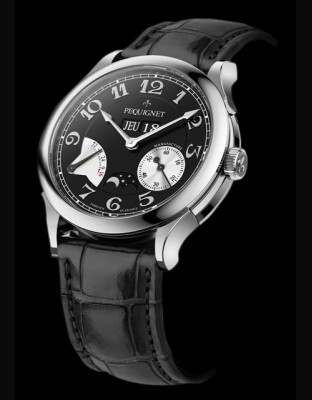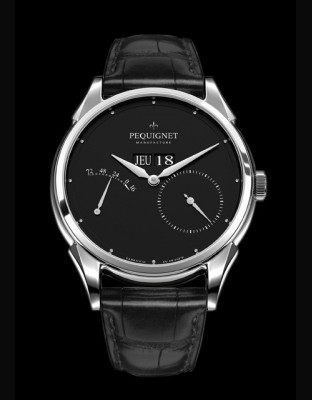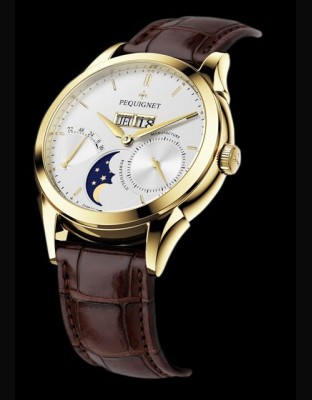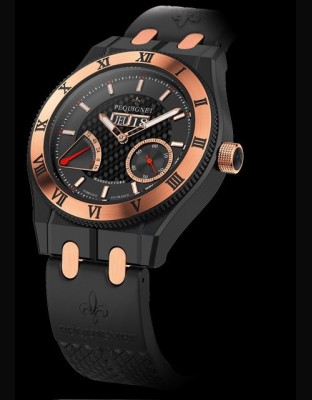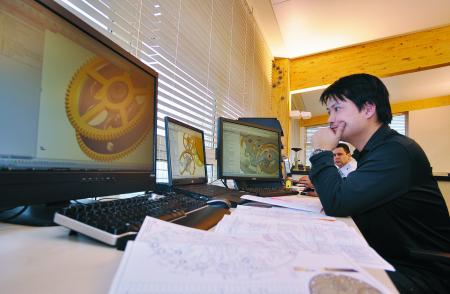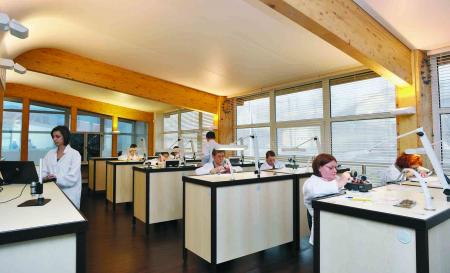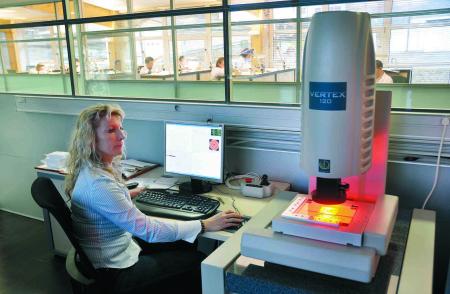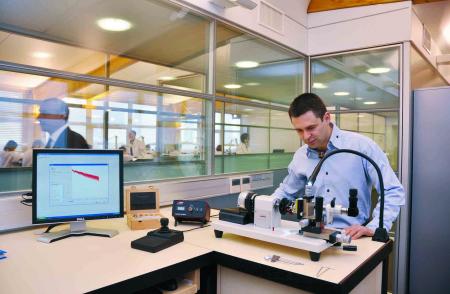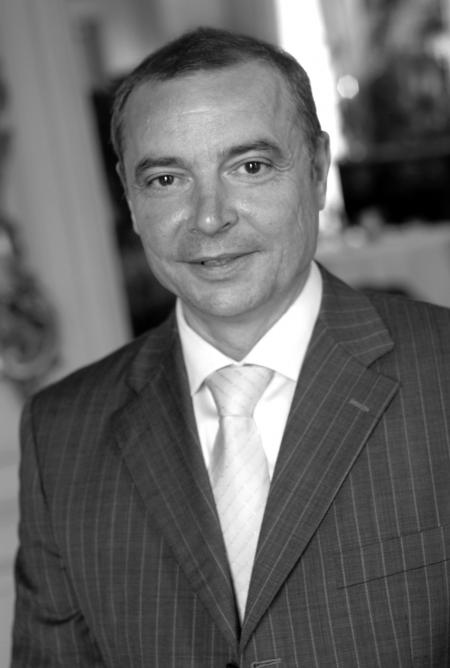1
pequignet

|
||
Brief history of the Pequignet brand and the origin of the Calibre Royal
Monsieur Emile Pequignet founded the Pequignet brand in 1973 in the town of Morteau, in the heart of the historic French Jura watch making region, a stone's throw from the town of Le Locle in Switzerland.
Monsieur Pequignet was a self-educated man, and his many talents served as his passport to success:
A horse rider of European renown, an accomplished musician and an exceptional skier, he began his career as a turner/miller on a revolutionary machine: the 'facet-cuttin...

THE COLLECTIONS

-
Paris Royal
SEE THE DATA SHEETBrand: Pequignet
Collection: Paris Royal
Ref: 9007543 CN
Price: 7 000 € -
Paris Royal
SEE THE DATA SHEETBrand: Pequignet
Collection: Paris Royal
Ref: 9007443 CN
Price: 7 000 € -
Paris Royal
SEE THE DATA SHEETBrand: Pequignet
Collection: Paris Royal
Ref: 9007437 CN
Price: 7 000 € -
Paris Royal
SEE THE DATA SHEETBrand: Pequignet
Collection: Paris Royal
Ref: 9007437 CG
Price: 7 000 € -
Paris Royal
SEE THE DATA SHEETBrand: Pequignet
Collection: Paris Royal
Ref: 9007433 CN
Price: 7 000 € -
Paris Royal
SEE THE DATA SHEETBrand: Pequignet
Collection: Paris Royal
Ref: 9007433 CG
Price: 7 000 € -
Royal Grand Sport
SEE THE DATA SHEETBrand: Pequignet
Collection: Royal Grand Sport
Ref: 9030643 CN
Price: 6 500 € -
Royal Grand Sport
SEE THE DATA SHEETBrand: Pequignet
Collection: Royal Grand Sport
Ref: 9030543 CN
Price: 7 500 € -
Royal Grand Sport
SEE THE DATA SHEETBrand: Pequignet
Collection: Royal Grand Sport
Ref: 9030443 CN
Price: 7 500 € -
Royal Grand Sport
SEE THE DATA SHEETBrand: Pequignet
Collection: Royal Grand Sport
Ref: 9030438 CN
Price: 7 500 € -
Royal Grand Sport
SEE THE DATA SHEETBrand: Pequignet
Collection: Royal Grand Sport
Ref: 9030438 CG
Price: 7 500 € -
Royal Grand Sport
SEE THE DATA SHEETBrand: Pequignet
Collection: Royal Grand Sport
Ref: 9030433 CN
Price: 7 500 € -
Royal Grand Sport
SEE THE DATA SHEETBrand: Pequignet
Collection: Royal Grand Sport
Ref: 9030433 CG
Price: 7 500 € -
Rue Royale
SEE THE DATA SHEETBrand: Pequignet
Collection: Rue Royale
Ref: 9011438 CN
Price: 17 000 € -
Rue Royale
SEE THE DATA SHEETBrand: Pequignet
Collection: Rue Royale
Ref: 9011438 CG
Price: 17 000 € -
Rue Royale
SEE THE DATA SHEETBrand: Pequignet
Collection: Rue Royale
Ref: 9010437 CN
Price: 7 000 € -
Rue Royale
SEE THE DATA SHEETBrand: Pequignet
Collection: Rue Royale
Ref: 9010433 CG
Price: 7 000 € -
Rue Royale
SEE THE DATA SHEETBrand: Pequignet
Collection: Rue Royale
Ref: 9011548 CN
Price: 17 000 € -
Rue Royale
SEE THE DATA SHEETBrand: Pequignet
Collection: Rue Royale
Ref: 9011538 CG
Price: 17 000 € -
Rue Royale
SEE THE DATA SHEETBrand: Pequignet
Collection: Rue Royale
Ref: 9010543 CN
Price: 7 000 € -
Rue Royale
SEE THE DATA SHEETBrand: Pequignet
Collection: Rue Royale
Ref: 9010443 CN
Price: 7 000 € -
Rue Royale
SEE THE DATA SHEETBrand: Pequignet
Collection: Rue Royale
Ref: 9010433 CN
Price: 7 000 € -
Paris Royal
SEE THE DATA SHEETBrand: Pequignet
Collection: Paris Royal
Ref: 9002438 CG
Price: 19 950 € -
Paris Royal
SEE THE DATA SHEETBrand: Pequignet
Collection: Paris Royal
Ref: 9000443 CN
Price: 19 000 € -
Moorea Royale
SEE THE DATA SHEETBrand: Pequignet
Collection: Moorea Royale
Ref: 9020448/30
Price: 7 500 € -
Paris Royal
SEE THE DATA SHEETBrand: Pequignet
Collection: Paris Royal
Ref: 9001438 CG
Price: 19 000 € -
Rue Royale
SEE THE DATA SHEETBrand: Pequignet
Collection: Rue Royale
Ref: 9010437 CG
Price: 7 000 €
Brief history of the Pequignet brand and the origin of the Calibre Royal
Monsieur Emile Pequignet founded the Pequignet brand in 1973 in the town of Morteau, in the heart of the historic French Jura watch making region, a stone's throw from the town of Le Locle in Switzerland.
Monsieur Pequignet was a self-educated man, and his many talents served as his passport to success:
A horse rider of European renown, an accomplished musician and an exceptional skier, he began his career as a turner/miller on a revolutionary machine: the 'facet-cutting machine'.
The year was 1960, when all watches were mechanical and fell into one of two general categories: the high-end pallet fork movement watch and the pin pallet movement watch, known as the 'Roskopf', at the low-price end. The movements may have been distinguishable, but the watch cases were often identical due to the absence of the facet-cutting machine. This was a revolution in terms of both watch cases and brass: the facet-cutting machine opened the way for beauty, dreams, curves, fine lines and imagined forms, allowing the watch case to break free of its constraints. Monsieur Pequignet was then able to apply these new and ingenious machine capabilities to the pursuit of beauty and creative expression.
Over the years, his models were awarded five 'CADRANS D'OR' (golden dials) prizes in the prestigious or luxury categories in Paris, 4 of which were for women's models where the brand's talent was expressed to its fullest: Moorea, Cameleone, Sorella. The 'CADRANS D'OR' contest in Paris rewards the artistic creativity of models.
The legitimacy and renown of the Pequignet brand are based on resolutely French interpretations of creativity, beauty and elegance, primarily expressed in women's collections which radiate the very highest Swiss quality. To date, Pequignet has received more awards than any other brand for its elegant, feminine, timeless and unusual watch making creations. The quality is unrivalled and, true to the brand watch making spirit, only the finest components are used. Furthermore, each Pequignet has carried its own unique number since the brand was created.
As it develops, the Pequignet brand is continually recreating the future, inventing the famous Moorea link bracelet, beautiful and comfortable, feminine or masculine, its renowned interchangeable bracelets and finally the first diamonds set in steel, a Pequignet specialty.
The brand established itself around its original core values: watch making and jewellery, independent and family-run, creative and innovative, the expression of distinctive watch making artistry, so wholly French in its elegance.
During the first decade of the 21st century, the creator was looking forward to a well-deserved retirement. On the 15th January 2004, Didier Leibundgut achieved his dream of becoming independent and reviving the watch making heritage of Morteau by acquiring the Pequignet brand based in Morteau itself. Leibundgut is one of three generations of watchmakers, his grandfather Charles having founded a small watch making manufacture in Morteau in 1920, known as RECTIUS HORA. This small watch making manufacture was highly active until 1975, borne along by the tidal wave of the quartz revolution. What a joy for a child to walk through the 'dispatch room', with the odour of new leather filling him with great dreams, to the sound of 2000 horological cicadas together creating the gentle, regular hum of a fragile mechanical heart. The seed was sown, for life... until death.
The watch making path is guided by meandering destiny: Russian watch making, with its magnificent pocket watches, its Komandirski watches and its astounding marine chronometers; later, the Zenith manufacture in Le Locle, with the El Primero movement producing 36,000 vibrations/hour…
The swing of a historic balance allowed watch making to re-establish its mechanical pedigree. Fine Swiss mechanics were back; better than ever and now stamped with the 'Métier d'Art' (craftsmanship) label.
The Pequignet brand then realized a great watch making ambition: the creation of an entirely new mechanical movement in an Haute Horlogerie laboratory incorporated in the brand in Morteau; a kind of watch making Holy Grail combining reliability, watch making performance (torque and precision), beauty and a full range of generously sized complications integrated in the base plate and displayed perfectly symmetrically on the dial. A watch making dream, and a 13 3/4 dream caliber incorporating the full range of complications all within a space measuring an elegant and precise 5.88 mm.
It required belief, reflection, an eye for the future, the exploration of the realm of the possible, the obsessive dream... The dream started to come alive, to take shape. Gérard, then Ludovic Pérez, then Huy Van Tran were all inspired by the same quest for the watch making Holy Grail and bound by a mutual friendship. The project took shape, through reflection, judgment, construction... then the realization hit home: this caliber was possible. The questioning became certainty, which translated into action. Ludovic Perez, Huy Van Tran and Philippe Blanchot joined Pequignet and set up an integrated Haute Horlogerie laboratory equipped with the very latest optical and numerical tools for all production stages from design to prototyping.
At Basel 2009, Pequignet unveiled a new, revolutionary 'watch case' caliber under the code name EPM01, whose performance, reliability and geometry allowed it to house the full range of watch making complications in its base plate with the utmost precision. Europa Star hailed this ambitious and innovative movement as 'the potential face of tomorrow's luxury watch making'.
On the 18th March 2010 at the Basel fair, the EPM01's real name was revealed - Calibre Royal - along with its Paris Royal, Rue Royale and Moorea Royal Triomphe collections. Beauty and watch making technology in perfect harmony: 250 technical drawings from the Pequignet laboratory. 165 Pequignet components and wheels. The best experts for each discipline, skill and component. A global industrial process incorporating tooling, dies and machine settings was implemented to make the first production series of 300 pieces, including the Calibre Royal. At 1, Rue du Bief in Morteau, France, under Ludovic's supremely steady hand, Van's creative eye and Philippe's careful vigilance, the heart of the very first series-produced Calibre Royal with integrated complications began to beat.
A beautiful baby. As watchmakers say, it was 'well-born' This expression, customary in watch making circles, means a caliber that fulfils all its potential when produced. In fact, after 12 months of operation, the 5 technical prototypes from Basel 2009 have not suffered a single fault…all below 10 seconds/day for prototype calibers. This seems exceptional, rare, improbable, yet it is true.
The very first Calibre Royals with fully integrated complications were scrutinized under electronic binoculars: 'it works, and rather well at that!'. A brand new crown winding system, a directly driven barrel drum, a completely innovative power reserve indicator device, an automatic bidirectional mechanism with very low resistance and friction...the watch making dream had become a reality. The dual Large Date and Day Window - a world-first and one of the rarest and most difficult watch making complications - is an integral feature of the caliber's complex yet reliable operation. Seven international patents are behind this promising success - three for the dual Large Date and Day Window alone.
'Blood will tell'. The Calibre Royal will warrant and justify its claim to exceptional reliability, with all its complications integrated, by meeting the challenge of unrivalled isochronisms and precision. No fewer than 6 months of testing, both in 2 renowned external laboratories and Pequignet's own in-house laboratory, were required to ensure the Calibre Royal can fulfill its promise of success to lovers of Haute Horlogerie. It underwent physical and thermal shocks, a full range of accelerated ageing processes, its most minute dimensions and clearances were scrutinized and its tiniest variations in precision were observed under harsh conditions. 220° in top vertical position after 72 hours of power reserve with all integrated complications functioning: watchmakers know that this kind of performance requires considerable patience.
The historic Pequignet brand has established itself primarily on its women's ranges and collections. The Calibre Royal, a Manufacture movement in every sense, has added a masculine dimension to the Manufacture's luxury offering. Pequignet, one of the only watch brands to have successfully extended its watch collections with the addition of a women's and men's jewellery collection, has acquired wide-ranging expertise over a period of more than thirty years. The brand has now established its domain, which features the Manufacture caliber, women's watch and jewellery collections, and women's and men's watches and jewellery united in harmonious elegance.
Sons Julien and Pierre Leibundgut joined the Pequignet brand in 2005 - the fourth generation to pursue the watch making dream at a company unique in both its creations and its status: watchmaker, jeweler, independent, family-run, artisan, down-to-earth, French.
The Calibre Royal is a graceful, almost majestic movement; our Japanese counterparts, real experts in decoding signs and symbols, are not easily mistaken. They recognized the Calibre Royal as a French caliber by its lines and symmetry - a caliber in the great tradition of French garden design. Truly Zen!
